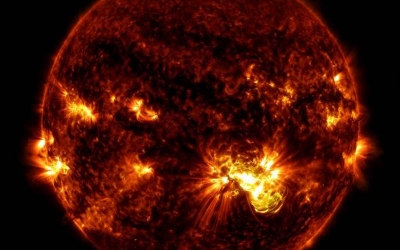
Temporary phenomena that occur on the sun, sunspots appear as spots that are darker than the surrounding areas. These seem dark to us only because of the difference in temperatures as these regions have reduced surface temperature as a result of intense magnetism.
There was a bitter dispute between Italian astronomer Galileo Galilei and German priest Christoph Scheiner in the 17th Century as to who deserved the credit for discovering sunspots. With hindsight, it is easy for us to tell now that the whole exercise was rather pointless due to two main reasons.
Dispute for what?
For one, sunspots had been observed for centuries before these two men came into the picture. There are surviving Chinese records that go back over 2,000 years that indicate possible sightings and also many mentions by Chinese astronomers. There were numerous other observations of sunspots through the centuries, only that the observers interpreted it mistakenly as the transit of a planet.
Secondly, historians now generally agree that Englishman Thomas Harriot was the first to observe sunspots using telescopes when he did it late in 1610. And even if we are looking at someone who published their findings, the credit for that would go to Dutch-German astronomer Johannes Fabricius.
Born Johann Goldsmid and better known by his Latinised name Johannes Fabricius, Johannes was the eldest son of Lutheran pastor and astronomer David Fabricius. While most of his early education in maths and science took place under his father’s watchful eyes, he was then supported by a wealthy patron.
World of telescopes
This meant that as a young man, Fabricius was able to finally pursue a more formal education. This took him first to the University of Helmstedt and University of Wittenberg in Germany and then to the University of Leiden in the Netherlands.
It was during his time at Leiden that Fabricius first encountered telescopes, which were an exciting new invention that was beginning to appear in the Netherlands. When he left for home, he carried with him several of these new telescopes to show his father. As David himself was an astronomer and had also worked with Europe’s celebrity astronomers such as Danish Tycho Brahe and German Johannes Kepler, Johannes was sure that his father would appreciate these new instruments.
Observe sunspots
Living then in Osteel, a town in the northwest part of Germany, father and son took to using the telescope to observe. On March 9, 1611, they rose at dawn and trained their telescope to view the sun and were surprised to see black spots on it. Direct observation, however, led to severe pain to the eyes, even if done before sunrise and after sunset.
This is best summarised in Fabricius’ own words (excerpt from a translation): “For indeed it was to be feared than an indiscreet examination of a lower sun would cause great injury to the eyes, for even the weaker rays of the setting or rising sun often inflame the eye with a strange redness, which may last for two days, not without affecting the appearance of objects.”
Given this situation, the duo switched to a camera obscura method of allowing the sun’s rays to enter a dark room through a pinhole opening and watching the resulting image on a sheet of paper. This allowed them to track and review the sunspot movement over subsequent sightings, enough to notice that the sunspot moved across the face of the sun, disappearing off one edge and reappearing at the other edge around two weeks later.
Publishes treatise
These observations were evidence of the sun’s rotation about its own axis. Fabricius ruled out planetary transits or clouds being responsible for these spots and rightly concluded that these spots were on the sun’s surface. He published their findings in a 22-page pamphlet titled “De Maculis in Sole observatis et Apparente earum cum Sole Conversione Narratio” (Narration on Spots Observed on the Sun and their Apparent Rotation with the Sun), which had its dedication dated June 13, 1611. This was the first published treatise that spoke about sunspots.
Isolated from the larger world and its leading astronomers and lacking influential backing, Fabricius’ work languished in obscurity for decades before it was identified for what it was. Unaware of what Fabricius had achieved, Galileo and Scheiner, who had their works on sunspots published in the following years, were embroiled in a bitter battle to stake a claim to the discovery.
All those sunspot sightings, which proved that the sun moved and changed, and wasn’t “perfect” as stated in religious dogma, along with other mounting evidence, meant that the fact that the sun is at the centre of the solar system finally came to be accepted as the truth within a generation. Fabricius wasn’t around to see that unfold, however, as he died at the rather young age of 29 in 1616. Sunspots, meanwhile, continue to fascinate humankind till this day.
Picture credit : Google



